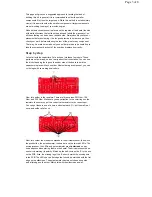
This page will give you a suggested approach to tackling the task of
building this kit. In general, it is recommended to solder the smaller
components first, then the larger ones. While this method is not absolutely
crucial, it is easier to solder the smaller components if larger components
are not blocking the way of your soldering iron.
Make sure each component is placed on the top side of the board (the side
with white silkscreen that outlines the parts and labels the piano keys), so
all the soldering can be done on the back side. Always double check your
placement before soldering. It’s also good practice to solder one pin, then
check your work, before soldering the rest of the pins for any component.
That way, if a mistake is made, only one solder joint has to be heated up to
take the component back out of the board and replaced correctly.
Step by step
Let’s start with the capacitors. Put each one into these four spots. These
parts are not polarized, so don’t worry about their orientation. You can use
the trick of bending the legs on the under side of the board to hold the
capacitors in place while you solder. After soldering a component, you can
cut its legs with some diagonal cutters.
Now, let’s solder in the resistors. There are three values, 2M Ohm, 10K
Ohm, and 330 Ohm. Make sure you pay attention to the color rings on the
resistors to ensure you put the correct value resistor in the correct spot.
You can put these in one at a time, and solder each. Or, put them all in at
once, and solder all at once.
Next, let’s solder the medium components: the microprocessor, the switch,
the pushbutton, the potentiometer, the header, and the two red LED’s. The
microprocessor, the LEDs, and potentiometer are all
polarized
, so pay
extra attention when placing them on the board! The microprocessor has a
semi-circle marking its polarity. Match up the half-circle on the IC to the one
on the PCB. Also, the missing leg of the IC should match the missing hole
in the PCB. The LEDs have a flat edge that should be matched with the flat
edge on the silkscreen. The potentiometer has two notches on one side
and a flat edge on the other. Match this with the silkscreen as well.
Page 3 of 8


























